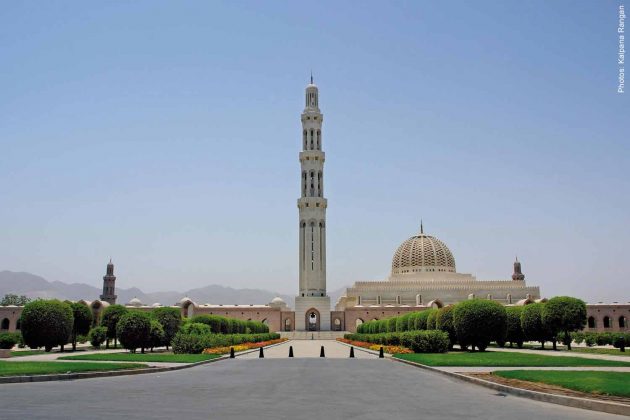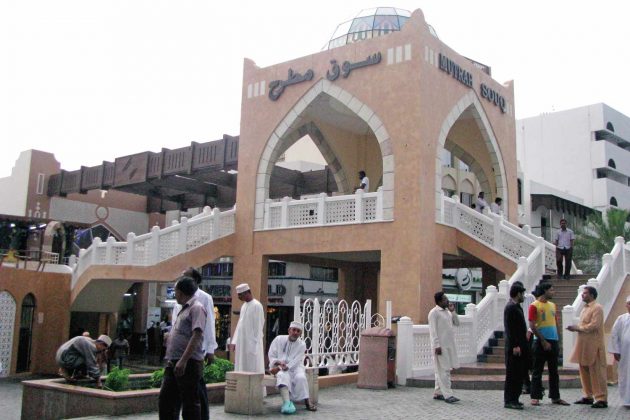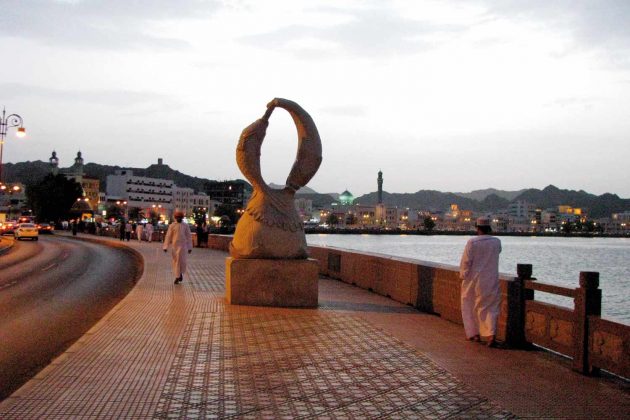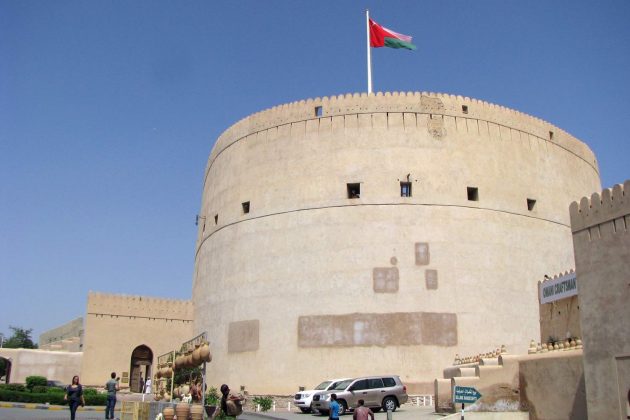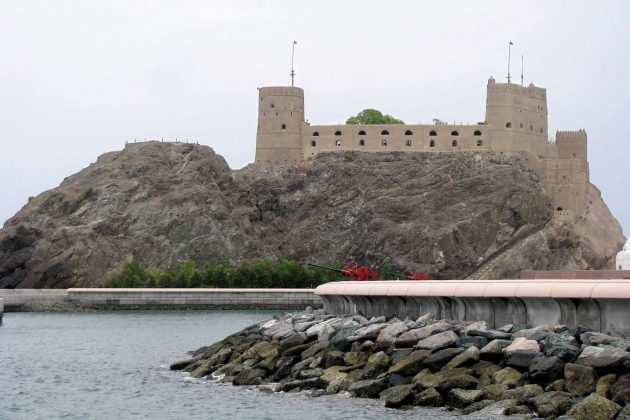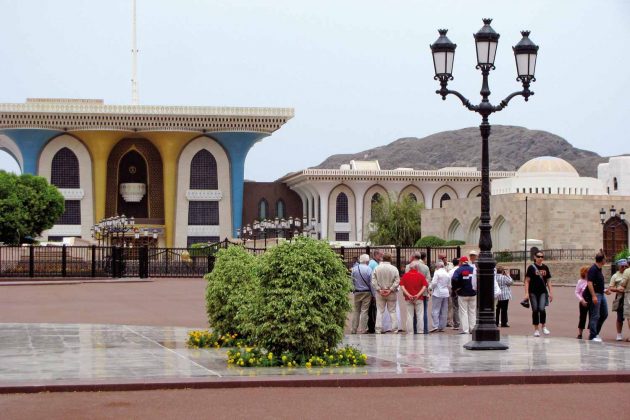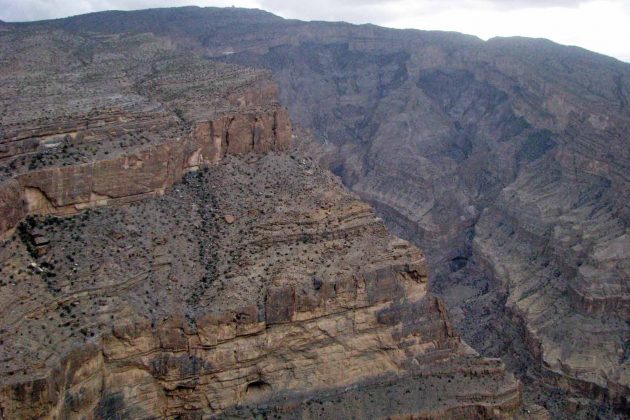Muscat is the starting point of any tour in Oman. It is a city of hills, forts, sands and beaches. Unlike in Dubai and Abu Dhabi, the skyline here is not cluttered with skyscrapers competing with each other to touch the sky, but it is a beautiful picture of hills gently rising and falling. You catch a glimpse of them peeking out behind the city’s structures even as you look out of your hotel room. Wherever you go, they are there. There are sandstone and limestone hills in shades of light to dark stony brown that loom large behind white structures and artistic mosques with designer domes. It is a natural landscape that contrasts beautifully with modern day structures.
Our exploration of Muscat started with a visit to the corniche in Muttrah. Our hotel was located in Ruwi and we took a mini van for 100 baiza per person [1000 baiza = 1 Omani rial] to reach Muttrah. You can also call for a private taxi or try other modes of public transport. Fifteen minutes later, when I first set my eyes on our destination, it reminded me of the Marine Drive of Mumbai.
Sea-side serenity
Muttrah corniche is buzzing with leisurely activity. It has museums, mosques, shops, souks, public gardens and a 4km walkway along the sea. As you walk along it, you will come across locals taking a stroll, watching the liners on the sea while relaxing on the seats, chatting with friends, fishing or enjoying a snack. It feels serene to walk along the path, and watch as the sun goes down casting its light on the liners parked on the waters. The Muttrah fort atop a hill looks majestic. All the while the breeze blows on your face and the call for the evening prayer stirs something inside you. At the end of the walkway, you are welcomed with fountains, hills and parks. You can climb up the little hill to see the symbolic incense burner built at the top. The hilltop offers a stunning view of the expanse around. You never get tired of taking pictures at the cornice.
On your way back, you will pass the Muttrah fort and might be tempted to go inside. Unfortunately, the fort is closed to public, but you can pose in front of it and take pictures. A little further ahead from the fort is the famed Muttrah souk. Its entrance is as attractive as the wares displayed inside. On either side of the narrow lanes of the bazaar are shops displaying curios, clothes, jewellery, spices, bags and perfumes. There is a vibrant energy about the place, which invigorates you as you amble along. Step into the shops to buy the traditional incense burner or the Omani sword. And go ahead and haggle all you want for the best price without hang-ups—haggling is not just allowed, it’s a way of life here in Oman as it is in other Arab countries.
Foreign tourists flock this place to buy souvenirs and silver jewellery or to simply experience the eclectic energy. When you are done with shopping, rest your feet at a nearby cafe and enjoy a cup of coffee and some delicious Arabian snacks. And if you have some time left, you can also book yourself for a dhow ride from one of the shops. An evening ride on the traditional boat on the cool waters to spot dolphins is a must-have experience.
Stunning structures
The Muscat Opera House demands attention with its beauty. The palm trees swaying around and the hills enhance its charm. This attractive white complex witnesses many concerts and ballet shows and is one of the favourite tourist hang-outs. A little further is the Qurum Beach with a large stretch of sand that lines its frothy waters. With hotels like the Shangrila close by, it is always populated by tourists enjoying water sports. From here too, you can take a boat ride to the land of dolphins and turtles. There are many such beaches in Muscat, frequented not just by tourists but also locals.
To explore Muscat further, it is best to go on a half day tour of the city. The first stop on such a tour is Sultan Qaboos Grand Mosque, which is a lovely structure inside-out. Built in sandstone and embellished with marble, it is named after the present Sultan of Oman. Inaugurated in 2001, the mosque has a prayer carpet that covers 4,343 sq. meters! It weighs 21 tonnes and has 28 shades of colours. No wonder it took four years and numerous craftsmen to produce this marvellous stretch of art that is also the second largest carpet in the world. To light up this exquisite carpet is a chandelier made with Italian Murano glass and Swarovski crystals that is 14 metres tall.
Another monument worth admiring is the Sultan’s Al Alam palace. Visitors can walk around the palace but are not allowed to enter it. Its entrance gates are colourful and artistic. Located near the Muscat bay, it is surrounded by two forts, Al Mirani and Al Jalali that face one another but are separated by the sea. Every morning and evening, cannon shots are fired from the forts signalling the start and end of the day. Walking from the palace towards the forts, one can have a breathtaking view of the harbour.
To familiarise yourself with the history of Oman, its culture and rulers, a visit to the Muscat Gate Museum and Bait al Zubair is recommended. While Bait al Zubair has a vast collection of costumes, weapons, jewellery and household items apart from the portrait gallery of the Sultans, the Muscat Gate Museum chronicles Oman’s history from the Neolithic times to the present day.
Captivating caves, moving mountains
To admire more natural and man-made marvels of Oman, take a day trip to visit Nizwa [the ancient capital of Oman], Al Hoota Caves and Jebel Akhdar and Jebel Shams. Situated at the foot of the Hajar mountains, Nizwa’s historic fort houses the widest tower of the country. Standing 40 metres tall and 50 meters wide, this tower is a landmark of the city. Climbing the narrow staircases to the tower and viewing the scene from above is fascinating. Below is the Nizwa Handicraft market with a beautiful display of clay pots, copper vessels and silverware. Well-crafted silver jewellery is a speciality.
As you drive out of Nizwa and drive towards Jebel Shams, you will pass through palm-filled oases and ancient villages. Your guide may suggest a stop over at the village of Misfah, a heritage village of mud houses and terraced gardens filled with trees like palm, plantain, dates and lime. At the foot of Jebel Shams, are the Al Hoota Caves, a natural wonder and the first tourist cave in the gulf region. A toy train takes you to the entrance of the cave. Once you enter, you are in a wonderland of stalagmite and stalactite formations in every shape and size. Safe walking pathways will lead you into the dim-lit interiors of the cave. Photography is prohibited inside as it may disturb the bats and other smaller animals inhabiting the place. And at the centre of the cave is an artificial lake that houses the rare blind fish.
From here the drive up to Jebel Shams is exciting. Going up the winding roads with barren hills on either side is thrilling. The Grand Canyon of this mountain also known as Wadi Nakhur is an amazing natural marvel. No picture can compensate for the fabulous view that you can have of the canyons from above. Adventure sports enthusiasts can indulge in abseiling [rock climbing technique] here but only under the guidance of a trainer. Tourists can stay in the Jebel Shams resort to enjoy views of the mountains and canyons at leisure.
Jebel Akhdar is the other mountain range referred to as the ‘Green Mountain.’ Driving up to this mountain you can observe slopes and terraces that are covered in vegetation throughout the year. Oman is the land of such mountains as well as wadis, palm groves, caves and forts, a land filled with marvellous structures and real scenery. As they rightly point out in Oman, beauty has an address!
| Fact Sheet | |
| Capital | Muscat |
| Spoken language | Arabic |
| Religion | Islam |
| Currency | Rial [1 rial = 1000 baiza] |
| Best time to visit | October to May |
Did you know?
Oman had declared 2012 as its Tourism year and Muscat has been chosen as the choice tourist destination of the Middle East. To lure tourists and make their trip to Oman pleasurable, Oman Air, the official airlines of Oman, is offering attractive travel packages to tourists. Whenever you decide to travel to any destination in 2012 via Muscat, Oman Air can arrange your hotel accommodation for a maximum of three nights and four days. If you book in a hotel for one night you can get another night free. And if you show your hotel booking receipt, you can get a visa on arrival at the airport for 5 Omani rials.
This was first published in the June 2012 issue of Complete Wellbeing.


